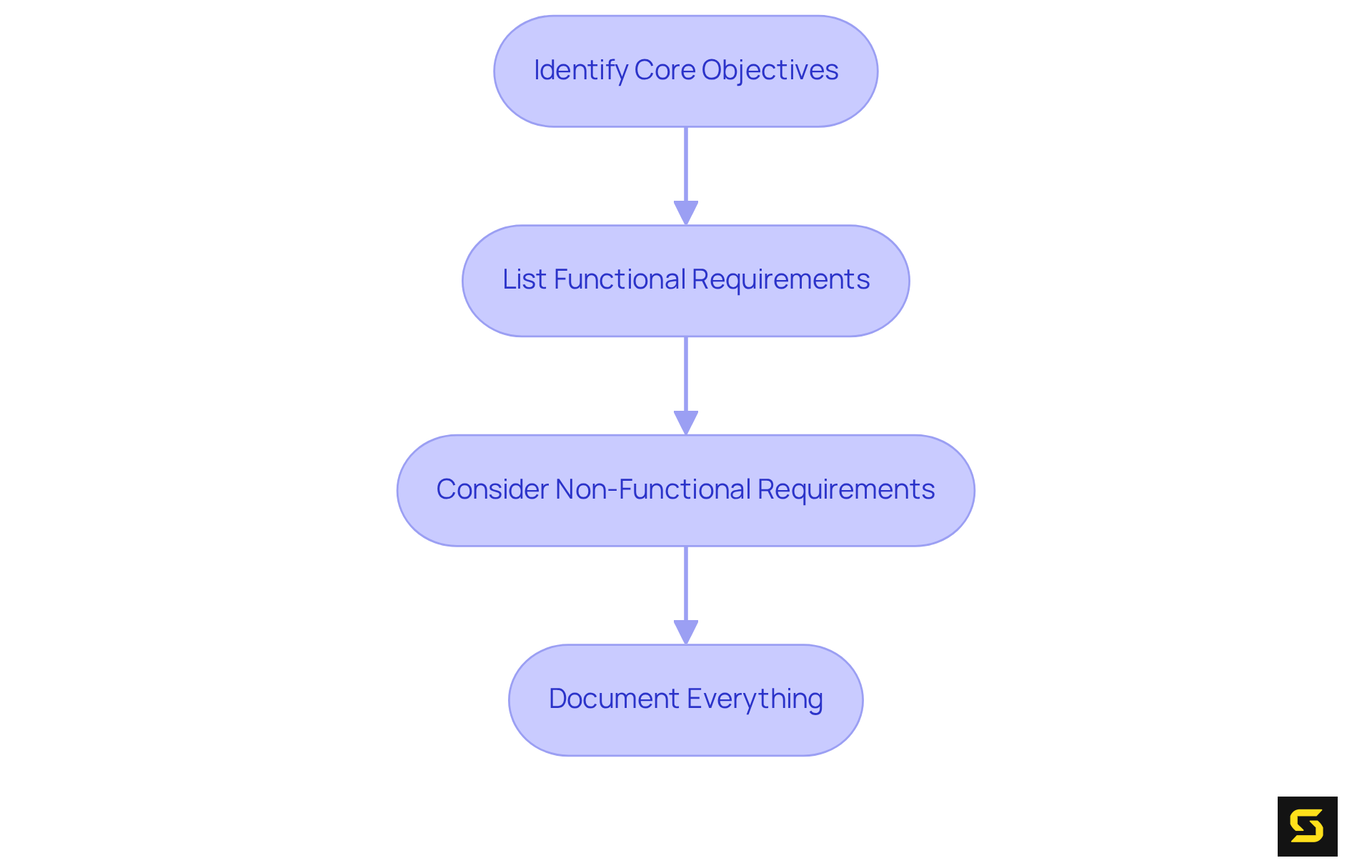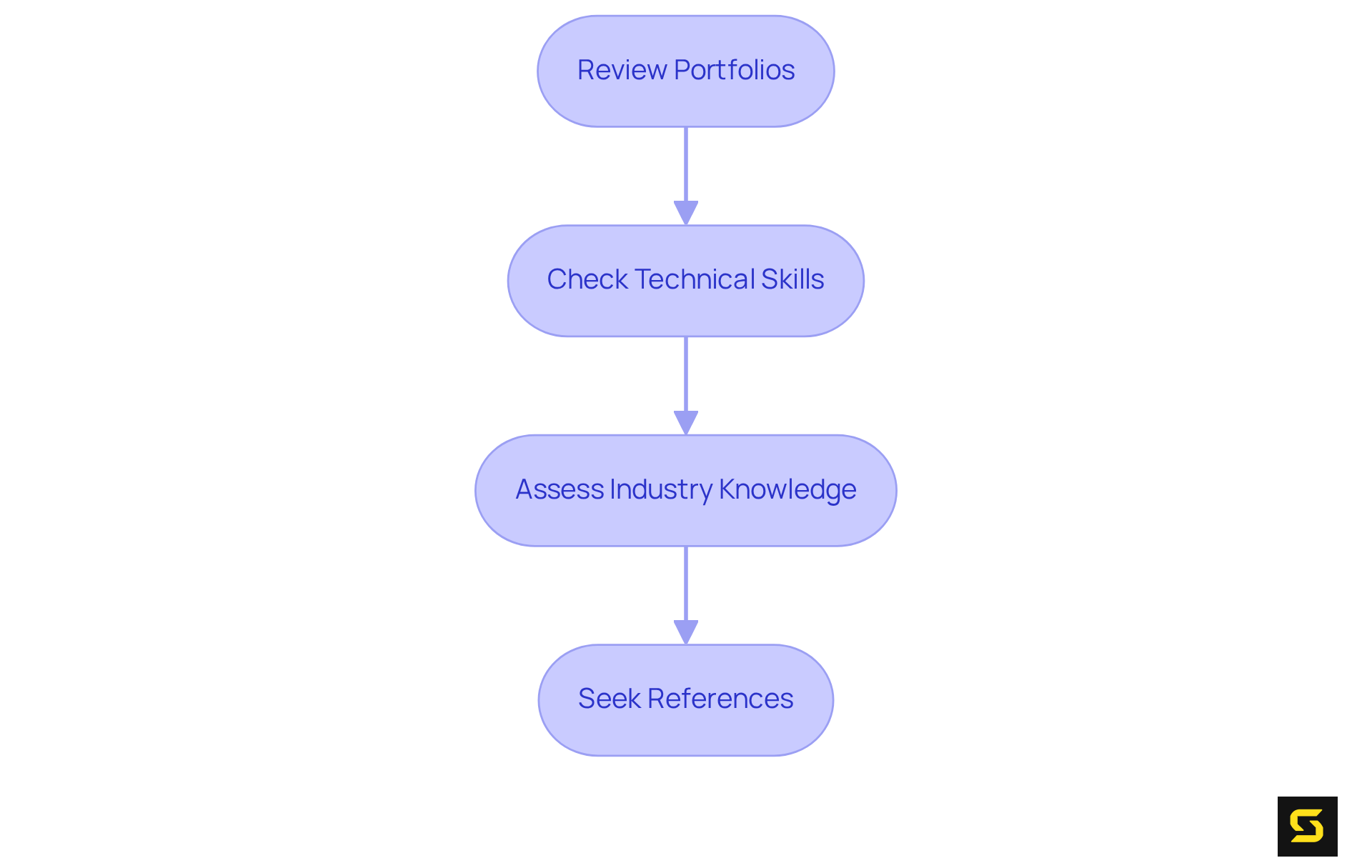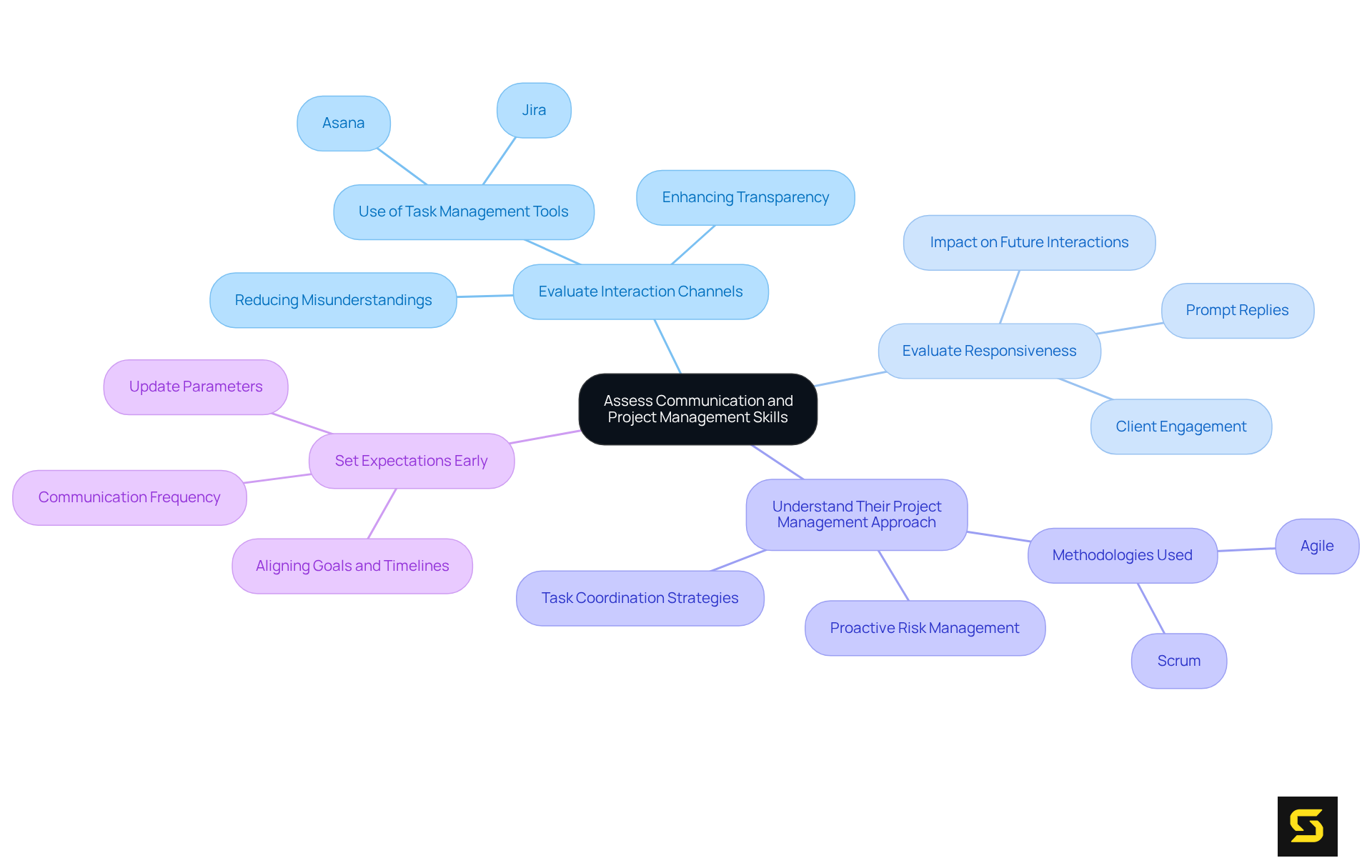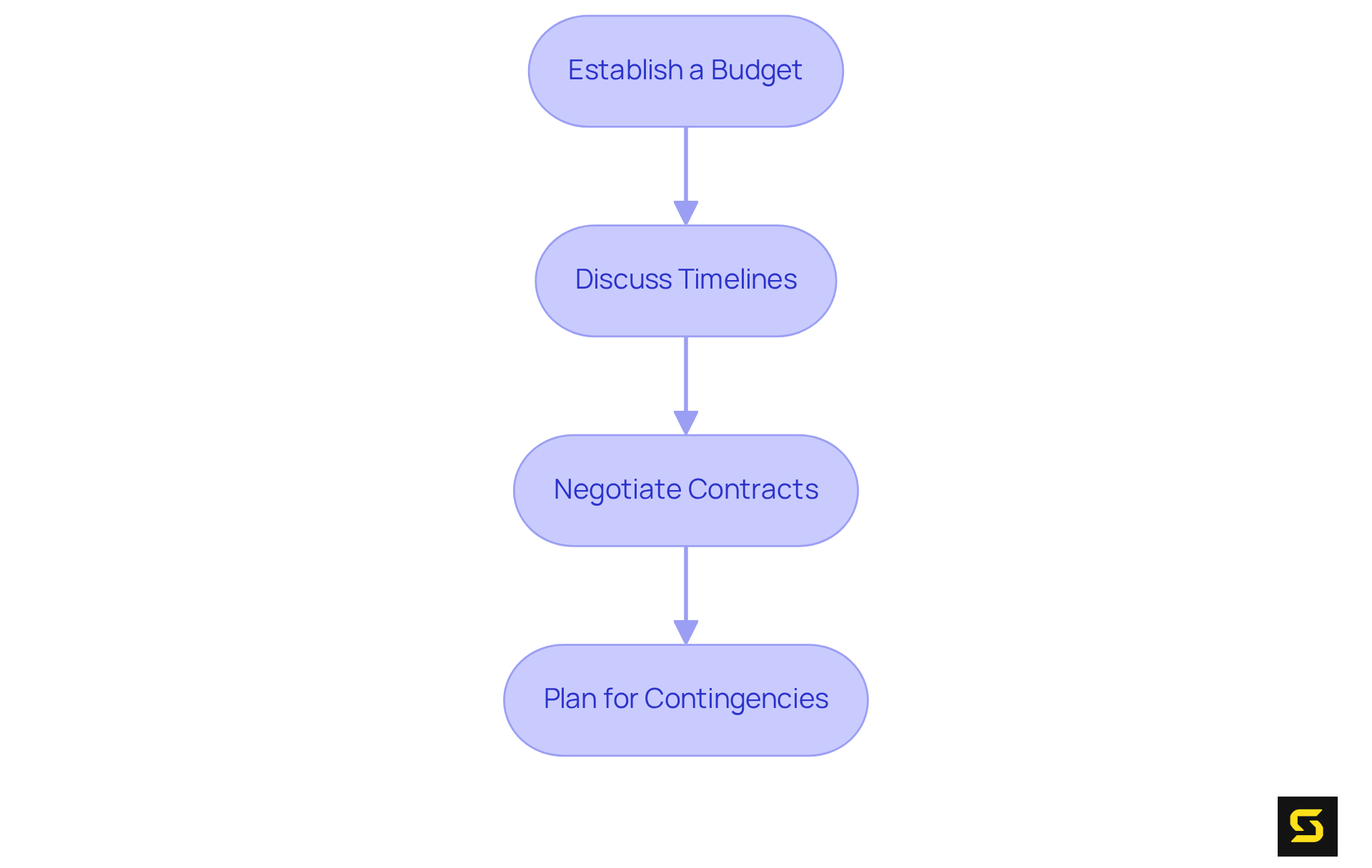Overview
Selecting the right mobile development company for your SaaS is a critical decision that requires careful consideration. Begin by defining your product goals, as this will serve as the foundation for your project. Next, evaluate the technical expertise of potential partners to ensure they possess the necessary skills to bring your vision to life.
It is equally important to assess their communication skills; effective dialogue is essential for a successful collaboration. Finally, clarify your budget and timelines upfront to align expectations and facilitate smooth planning.
This structured approach underscores the significance of having clear objectives, conducting thorough evaluations of prospective partners, maintaining effective communication, and engaging in upfront planning. By adhering to these principles, you can ensure a successful development process that meets your needs.
Introduction
Selecting the ideal mobile development company for a Software as a Service (SaaS) product can resemble navigating a complex maze, particularly given the high stakes present in today’s competitive landscape. A fruitful partnership is contingent not only on technical expertise but also on collaborating with a company that comprehends the unique goals and requirements inherent to the SaaS model.
How can businesses guarantee they choose a development partner capable of not only fulfilling their needs but also enhancing their product amidst a saturated market? This guide will delve into the essential steps necessary for making an informed decision—ranging from defining product goals to assessing communication skills—ultimately paving the way for a successful development journey.
Define Your SaaS Product Goals and Requirements
-
Identify Core Objectives: Begin by clearly outlining the primary purpose of your SaaS product. What specific problem does it address? Who constitutes your intended audience? This clarity will serve as a guiding principle for all subsequent decisions. A well-defined SaaS product strategy is essential for steering cross-functional teams, underscoring the importance of establishing clear objectives.
-
List Functional Requirements: Develop a comprehensive list of essential features your product must possess. This may encompass individual authentication, data storage, reporting capabilities, and more. Prioritize these features according to customer needs and business goals. It's noteworthy that 85% of SaaS budgets are allocated to renewals, with only 15% directed towards new application purchases, emphasizing the critical need for effective resource allocation.
-
Consider Non-Functional Requirements: Reflect on performance metrics, including scalability, security, and compliance. These elements are vital for long-term success and fostering user trust. The global SaaS market is projected to reach $300 billion by 2025, highlighting the competitive landscape and the necessity for well-defined product objectives.
-
Document Everything: Assemble your findings into a comprehensive requirements document. This will serve as a crucial reference point for both you and the development team throughout the project. Incorporating insights from successful case studies, particularly those that exemplify the effectiveness of setting SMART goals, can significantly enhance your documentation.

Evaluate Technical Expertise and Industry Experience
-
Review Portfolios: Thoroughly examine the portfolios of potential mobile development companies. Focus on projects that mirror your own in complexity and industry. A well-curated portfolio not only displays technical skills but also demonstrates the company's comprehension of client requirements and market trends. Firms that prioritize client insights often outperform rivals by 85% in sales growth, and organizations utilizing customer feedback effectively see a 30% increase in customer retention rates. This underscores the necessity of aligning with a mobile development company that truly understands your target audience.
-
Check the technical skills of the mobile development company to ensure it has expertise in the technologies you intend to utilize, such as JavaScript, React, or PHP. Inquire about their development processes and methodologies. Companies employing robust skills assessments often report a 25% faster project completion rate, while firms utilizing advanced skills evaluation tools experience a 20% reduction in employee turnover. This highlights the critical value of technical proficiency in achieving timely results and maintaining a stable workforce.
-
Assess Industry Knowledge: Evaluate the experience of the mobile development company within your specific industry. Firms familiar with your sector are better equipped to navigate challenges and meet user expectations. For instance, a healthcare-specialized developer can ensure compliance with regulations like HIPAA, which is crucial for patient management applications. A case study of MedFlow illustrates the dire consequences of not having a healthcare-specialized developer, as their initial app failed compliance audits, leading to costly delays. This industry-specific knowledge can significantly mitigate the risk of compliance failures.
-
Seek References: Request references from former clients to gain insights into the company's dependability, interaction, and ability to meet deadlines. A mid-sized firm that implemented KPIs for software efficacy saved approximately $150,000 annually by streamlining operations, demonstrating the tangible benefits of collaborating with a developer who values accountability and performance metrics. Engaging with past clients of a mobile development company can provide a clearer picture of what to expect and empower you to make an informed decision.

Assess Communication and Project Management Skills
-
Evaluate Interaction Channels: Effective exchange is paramount in any development partnership. Assess how the mobile development company engages with clients—do they utilize task organization tools such as Asana or Jira? A systematic interaction method, supported by these tools, significantly enhances transparency and alignment within the initiative, thereby reducing the likelihood of misunderstandings. A 2024 report reveals that organizations with developed project management practices achieve a remarkable 92% success rate, underscoring the critical role of efficient interaction in project success.
-
Evaluate Responsiveness: The speed at which a company responds to inquiries during initial discussions serves as a strong indicator of their overall interaction style. Prompt replies often reflect a genuine commitment to client engagement and can set a positive tone for future interactions. Insufficient responsiveness may lead to client dissatisfaction and unmet software expectations, highlighting the importance of effective communication.
-
Understand Their Project Management Approach: Inquire about the methodologies they employ, such as Agile or Scrum. A well-defined initiative oversight strategy implemented by a mobile development company not only fosters adaptability but also enhances the likelihood of favorable outcomes. Organizations that implement optimal strategies in task coordination frequently experience increased productivity and improved communication, both of which are essential for SaaS development. Furthermore, proactive risk management is vital; coordinators must identify potential hazards early to mitigate disruptions and keep initiatives on track.
-
Set Expectations Early: Clearly articulate your expectations regarding communication frequency and updates from the outset. Establishing these parameters cultivates a collaborative working relationship, ensuring that both parties align on goals and timelines. This proactive approach minimizes interruptions and supports successful collaboration, emphasizing the vital role of management in aligning product objectives with user requirements.

Clarify Budget, Timelines, and Contracts Upfront
-
Establish a Budget: Clearly define your investment range for developing your SaaS product. Be realistic about what you can afford while considering the quality of work. Notably, the average amount spent on SaaS per employee is $3,916, which provides a clearer context for your budgeting decisions. A well-structured budget serves as a growth enabler rather than a constraint.
-
Discuss Timelines: Establish a timeline for key milestones and final delivery. It is crucial to ensure that the mobile development company can adhere to these deadlines without sacrificing quality. A well-structured timeline significantly influences success, with those consistently outperforming those lacking adequate planning. A reliable guideline is to maintain a buffer of 10-15% of the overall timeline to accommodate unforeseen adjustments.
-
Negotiate Contracts: Carefully review contract terms, focusing on payment schedules, deliverables, and clauses related to potential changes in scope. Engaging in thorough negotiations prevents misunderstandings and ensures that both parties align on expectations. As industry leaders emphasize, clarity in contracts is vital for fostering accountability and responsible resource consumption in a mobile development company.
-
Plan for Contingencies: Discuss potential risks and outline strategies for managing them. Having a contingency plan saves time and resources when unexpected challenges arise. For instance, during a website launch project, adding new features mid-project extended the timeline significantly, underscoring the importance of proactive planning and flexibility in project management.

Conclusion
Choosing the right mobile development company for a Software as a Service (SaaS) product is a pivotal decision that can profoundly influence the project's success. By meticulously defining product goals and requirements, evaluating technical expertise and industry experience, assessing communication and project management skills, and clarifying budget and timelines, stakeholders can make informed choices that align seamlessly with their business objectives.
This article delineates a structured approach to selecting a mobile development partner, underscoring the necessity of comprehending core objectives, functional and non-functional requirements, and the specific demands of the industry. It stresses the importance of thorough evaluations, from scrutinizing portfolios and technical skills to analyzing communication practices and project management methodologies. Establishing clear budgets and timelines from the outset ensures that both parties are aligned and prepared for potential challenges.
Ultimately, the process of selecting a mobile development company should not be hurried. It necessitates careful consideration and strategic planning to cultivate a successful partnership. By adhering to these best practices, businesses can significantly enhance their chances of engaging a capable development team that not only fulfills their immediate needs but also supports their long-term goals in an increasingly competitive SaaS landscape. Investing the necessary time in this decision will pave the way for a product that resonates with users and distinguishes itself in the market.
Frequently Asked Questions
What are the core objectives to define for a SaaS product?
Core objectives involve outlining the primary purpose of the SaaS product, identifying the specific problem it addresses, and determining the intended audience. This clarity guides all subsequent decisions.
What should be included in the list of functional requirements for a SaaS product?
The list of functional requirements should include essential features such as individual authentication, data storage, reporting capabilities, and more. These features should be prioritized based on customer needs and business goals.
Why is it important to consider non-functional requirements in a SaaS product?
Non-functional requirements, such as scalability, security, and compliance, are vital for long-term success and building user trust. They contribute to the product's overall performance and reliability.
How should the findings about product goals and requirements be documented?
Findings should be assembled into a comprehensive requirements document that serves as a reference point for both the project team and the development team throughout the project.
What is the significance of setting SMART goals in the context of SaaS product development?
Incorporating insights from successful case studies that exemplify the effectiveness of setting SMART goals can significantly enhance the documentation and overall project clarity.
What does the allocation of SaaS budgets indicate about resource management?
The allocation of SaaS budgets, where 85% is directed towards renewals and only 15% towards new application purchases, emphasizes the critical need for effective resource allocation in product development.
What is the projected growth of the global SaaS market?
The global SaaS market is projected to reach $300 billion by 2025, highlighting the competitive landscape and the necessity for well-defined product objectives.





